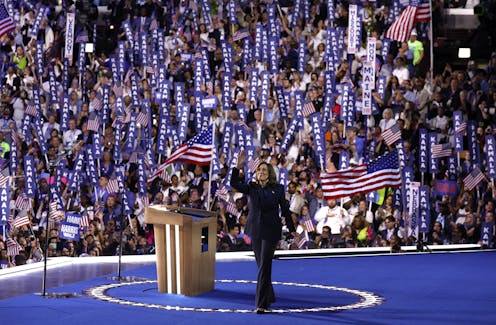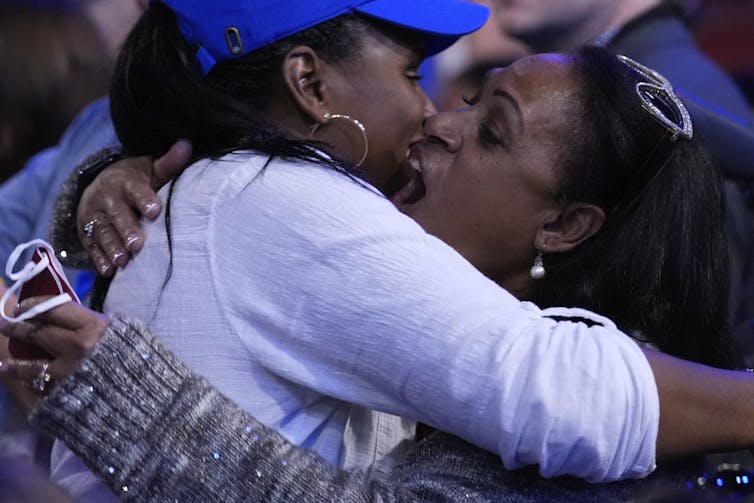Signs, props and light-up wristbands − the 2024 political conventions find a home in the Smithsonian
The Whigs started holding political conventions in the 1830s − and historians from the Smithsonian who visited the GOP and Democratic conventions this year found the tradition is still very vibrant.

The cheering, clapping and speechifying are over. Historians from the Smithsonian’s National Museum of American History have returned after their trips to the 2024 political party conventions to collect materials – from balloons to banners to blinking wristbands – at each of them. For the last in a series of interviews with the political history curators, The Conversation’s senior politics editor, Naomi Schalit, spoke with Claire Jerry, Jon Grinspan and Lisa Kathleen Graddy to learn about their haul from the recent Democratic convention – and what observations they’d made, as historians, at both parties’ events.
Schalit: What have you been thinking about since you left the Democratic convention?
Graddy: I’m always fascinated by props that people use. Because they made so much of it, I’ve been thinking about the giant prop book of Project 2025. It kept coming up again and again at the convention. It was a staple of the nights. I think we’d be interested in seeing if we can track that down. The fact that they even made a prop and used it for that many nights, rather than a one-time moment, is interesting to begin with, as well as the ways they kept coming back to it.
Schalit: That’s certainly a frequently seen artifact of the convention. Were there others?
Grinspan: Those light-up bracelets. If you were watching when Harris accepted and gave her speech, they had this big thing, and then all the lights were going. They gave out these individual bracelets that were on seats. We collected several of them, just a little blue wristband with a light-up bracelet. They’re wireless, and when they dim the regular lights, they flash red and yellow and blue.
They have no content, no meaning. But it’s just interesting to me the way conventions haven’t really changed. For 200 years, we’ve been doing the same thing, where the party faithful are in a building, and you have to get them fired up and send them home with all the different – sometimes meaningful, sometimes silly – ways you can rally the troops. And this was just a nice little material example of the same question: How do you get a group of people in one room excited? And this time they came up with this thing, and it’s just a nice physical demonstration of how, in 2024, this is how you got people excited, versus in 1924, this is how you got people excited. That’s the new answer to a fundamental question.
Schalit: Do you remember, off the top of your head, what might have gotten people excited in 1924?
Grinspan: They often had fireworks outside of conventions. These bracelets would be sort of fireworks inside the convention, using new technology.
Schalit: As historians, are you able to tell a story of these two conventions to the museumgoers of the future? Can you put it all together?
Grinspan: One thing I’ve been thinking about is the incredible energy and enthusiasm of people who are partisans, at a time when there’s such apathy from people who aren’t in those parties. At both these conventions, when you’re there, it really feels like this is the entire universe. Everyone is so excited.
And then you get out and you get in an Uber, and the Uber driver says, “Oh, I’m not gonna vote for either of those people.”
So this world we live in where people who are committed to their partisan identity, it’s a really big part of their identity. And then a lot of people still look at this election and say, “I don’t like either of those candidates. I’m not going to vote even.” The exaggeration of partisan identity for the faithful and the apathy, still, from so many people is just a really interesting contrast.
Schalit: Is there something that these conventions tell you specifically about this moment?
Grinspan: The way partisanship is more a factor of people’s identity now than it was in the 20th century. People had political views, of course, in the 20th century; they cared, right? But the way these have become tribes, and there’s a Democratic tribe and a Republican tribe, and it’s really core.
You can see that in the people who are circulating around, and you can ID what a Democrat looks like getting off the plane in Chicago versus a Republican in Milwaukee. You’re not always right, but this is borne out by so many statistics, the way these have gone from two parties that want to run the government to two growing camps, tribal camps. It’s palpable, and it’s not just in the statistics – it’s in the way people dress and behave and the way they organize their convention and all these other things.
Schalit: Can you describe one difference?
Grinspan: I noticed at the Republican convention, the men wear very expensive shoes and have fancy haircuts, and the women often wear kind of Fox News-style dresses. And then at the Democratic convention, there’s so much more diversity of clothing. I don’t mean diversity – racial, ethnic – just the different styles and appearances are so varied, there’s less of a uniform.

Schalit: Do you have some final thoughts to help people understand what you do and what you’ve learned from these two conventions?
Grinspan: I was surprised that both parties pulled off exciting and significant and meaningful conventions. I thought after the pandemic necessitated virtual conventions in 2020, maybe we just weren’t going to be doing conventions to the same scale anymore. The Whigs started doing conventions in the 1830s, and maybe it’s just an antiquated tradition. And after disruptions and the way, since 2016, we’ve shaken up so many norms of politics, I thought maybe they’ll just go away.
But I really found the conventions powerful and significant. I don’t know what change it’ll make in the polls, but I do think it matters for the people who are engaged in those parties. And I just find that surprising – this really old tradition that seems really analog, right? You’re putting these people in one room. It seems so not-21st century, but it still has some meaning and some power that you can’t do online.
Graddy: I loved watching when delegates, sometimes from different states or from different parts of their state, were seeing each other in corridors and rushing toward each other and embracing. It was fantastic. The fact that they were so thrilled to see each other and the immediate, intense conversations that were going on – I felt like some of this was because of 2020 when they hadn’t been able to have that, there was this longing to reconnect. Both parties are doing it because they’re convinced that personal contact will make a difference.
Jerry: Anybody who’s a convention delegate already is pretty committed, right? They know who they’re going to vote for. They know what their party is – and they still want to see their candidate in person. It matters to them to be sharing that space with somebody. They’re not being convinced to vote for this person at that moment, but they still want to be there.
The authors do not work for, consult, own shares in or receive funding from any company or organization that would benefit from this article, and have disclosed no relevant affiliations beyond their academic appointment.
Read These Next
West Antarctica’s history of rapid melting foretells sudden shifts in continent’s ‘catastrophic’ geo
A picture of what West Antarctica looked like when its ice sheet melted in the past can offer insight…
How the ‘slayer rule’ might play a role in determining who will inherit wealth from Rob Reiner and h
These rules have a long history in the United States. They played a role in the notorious murders by…
The celibate, dancing Shakers were once seen as a threat to society – 250 years later, they’re part
‘The Testament of Ann Lee,’ Mona Fastvold’s 2025 film, depicts part of the long history of Shaker…






